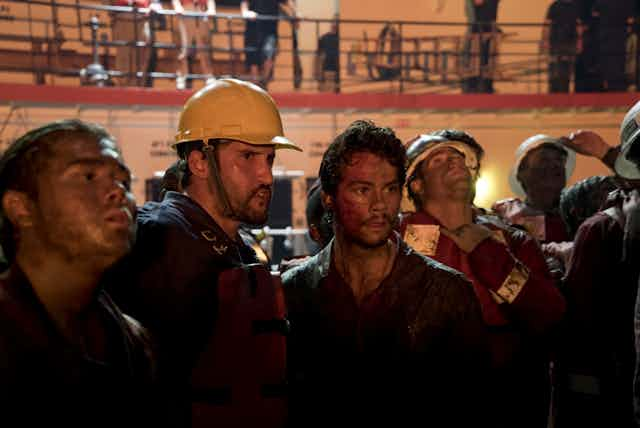Early on in the new Peter Berg film, Deepwater Horizon, the daughter of chief electronics technician Mike Williams (Mark Wahlberg), using a coke can as a prop, explains how oil exploration works, talking proudly of how “my daddy tames the dinosaurs”. The can spectacularly explodes while the daughter admits that “oil is a monster”.
Deepwater Horizon is the story of people’s relationship with oil. It is also a story of how badly this relationship can play out.
The film is a dramatisation of the 2010 disaster in the Gulf of Mexico, in which the mobile offshore drilling platform Deepwater Horizon, operated by Transocean and leased to BP, suffered an explosion from an oil blowout. The rig sank, while the blowout led to the world’s largest oil spill and a major environmental catastrophe.
The film is billed as the story often forgotten by accounts of the disaster. Rather than cover the environmental catastrophe, the film provides what Wahlberg has called “the human side of the story”, covering only the immediate prelude to and aftermath of the explosion at the rig. “Based on true events,” the film is peppered with sound recordings, authentic detail and technical information.
With the exception of a few notable villains, the human story is about heroes. It is very much a “tribute” piece. It’s the familiar trope of “good guy” blue-collar Americans (that if left alone could actually do their job) who are victims of outside meddling. They are real and relatable people. We innately sympathise with bridge officer Andrea Fleytas (Gina Rodriguez) who can’t quite get her vintage automobile working, nor direct the oil rig to safety.

Casting a post-9/11 lens on the proceedings, we see a crewman from the rig-operating company Transocean sacrificing himself to save his friends, as a smouldering rig – a veritable skyscraper on water – collapses. A US flag burns while workers leap ten stories into the ocean below. Those rescued gather together on a nearby ship and recite The Lord’s Prayer with another American flag in the background.
The end credits list the 11 real-life victims of the disaster alongside their pictures. The film is sentimental and powerful. When Williams emerges from the carnage disorientated and aghast, you feel his vulnerability (a credit to Wahlberg’s acting). Unlike many Hollywood disaster movies, Berg’s picture tackles trauma maturely and with sensitivity.
Taming the kraken
But for a film about an oil disaster, oil doesn’t come off that badly. Yes, it’s an unruly “monster” that the rig workers are rightly superstitious and wary of. Scenes below the ocean, of a kraken awakening, aim for a Jaws or Abyss-like quality. But the black stuff is also framed as the essential lifeblood of a nation. The Trans-ocean workers reside in an oil landscape whether on or off the rig. They turn on hobs and queue up at the gas station. Berg highlights this 24-hour industrial landscape well: you can almost smell the gasoline. Deepwater Horizon’s America is not a land of Teslas and Prius’, but of countless SUVs, and there seems nothing fundamentally wrong with this. Rather than a dwindling commodity, oil is everywhere in abundance.
The real villains of the story are neither gas-guzzling Americans nor oil as a product, but the corporate behemoth of BP. BP executives brazenly ignore risks in the quest for profit, blindly committed to the idea that “Houston doesn’t have a problem”. The film replays press coverage of the time that typically targeted BP but failed to recognise the wider problems at work. Berg sets up a familiar good-versus-evil narrative, pitting straight-talking rig manager Jimmy Harrell (Kurt Russell) against untrustworthy BP rep Donald Vidrine (John Malkovich).
But there’s a bigger story here, one that involves Transocean, a manager for oil contractor Halliburton (who destroyed evidence relating to the company’s role in the leak), along with poor industry regulation and flawed government oversight.

The film ends with just one sentence detailing how Deepwater Horizon became the worst environmental disaster in US history. And there lies the missed opportunity of the picture. While Hollywood identifies the spill as important, and worthy of exploration, it shies from advocating real change or pushing an environmental agenda.
It’s a Hollywood disaster movie, not an environmental movie: more The Towering Inferno than An Inconvenient Truth. The only obvious reference to an unfolding environmental disaster is a few oil-drenched birds crash-landing onto the rescue vessel.

But the real story of Deepwater Horizon had another 87 days to play out and 210m US gallons to leak, with devastating effects on Gulf Coast marine life. With no environmental disaster caught on film, there is also no hint of tackling the bigger issues at the heart of all this tragedy: oil dependency, environmental exploitation and climate change. Even though we learn that the heroes turn their back on the oil industry (and never return to rigs), there is no incitation for the audience to do likewise.
While Deepwater Horizon achieves emotional impact, it ultimately replaces a troubling story of environmental disaster with a reassuring tale of human spirit. It is Hollywood playing it safe.
Berg explained his motives for the film: “To this day, when people think of Deepwater Horizon, they only think of an oil spill – they think of an oil spill and dead pelicans.” But the dead pelicans matter. We need more environmental stories, not less. Deepwater Horizon is best understood as a story of both human and environmental loss.

